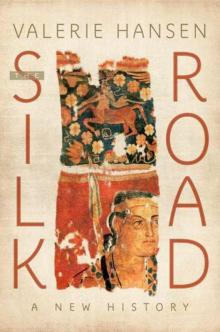Read The Silk Road: A New History Storyline:
The Silk Road is as iconic in world history as the Colossus of Rhodes or the Suez Canal. But what was it, exactly? It conjures up a hazy image of a caravan of camels laden with silk on a dusty desert track, reaching from China to Rome. The reality was different--and far more interesting--as revealed in this new history.In The Silk Road, Valerie Hansen describes the remarkable archeological finds that revolutionize our understanding of these trade routes. For centuries, key records remained hidden-sometimes deliberately buried by bureaucrats for safe keeping. But the sands of the Taklamakan Desert have revealed fascinating material, sometimes preserved by illiterate locals who recycled official documents to make insoles for shoes or garments for the dead. Hansen explores seven oases along the road, from Xi'an to Samarkand, where merchants, envoys, pilgrims, and travelers mixed in cosmopolitan communities, tolerant of religions from Buddhism to Zoroastrianism. There was no single, continuous road, but a chain of markets that traded between east and west. China and the Roman Empire had very little direct trade. China's main partners were the peoples of modern-day Iran, whose tombs in China reveal much about their Zoroastrian beliefs. Silk was not the most important good on the road; paper, invented in China before Julius Caesar was born, had a bigger impact in Europe, while metals, spices, and glass were just as important as silk. Perhaps most significant of all was the road's transmission of ideas, technologies, and artistic motifs.The Silk Road is a fascinating story of archeological discovery, cultural transmission, and the intricate chains across Central Asia and China.Amazon.com ReviewAmazon.com Additional Content: Silk Road Photo Gallery (Click on Images to Enlarge)Here is a sample of the stunning photographs of documents and art objects that appear in The Silk Road: A New History. How the Silk Road Got Its NameThe German geographer Ferdinand von Richthofen coined the term "Silk Road" with the publication of this map in 1877. Before this date, people referred to the route as the road to Samarkand (or whatever the next major city was).Tang BarbieWhen this seventh-century Chinese beauty was on display at the Metropolitan Museum of Art, the staff nicknamed her "Tang Barbie" because she was the same height as the children's doll and every bit as fashionable. Her arms are made from recycled paper that turned out to be important documents from a pawnshop.Ancient NiyaWorn by the centuries, the outer layer of Niya's stupa has been stripped away, revealing the bricks underneath. Wooden documents found at this site are a treasure trove of information about life on the Silk Road in the third and fourth centuries.Zoroastrian Art from Xi'anThis Sogdian tomb has a typical Chinese stone tomb entranceway with Zoroastrian art above the doorway. Zoroastrian imagery found in tombs like this is much more detailed and much more informative than anything that survives in the Iranian homeland of Zoroastrianism.When Rivers Flowed Through the Taklamakan DesertMost riverbeds in the Taklamakan Desert today are bone dry, but in 1899 the Swedish explorer Sven Hedin used this 38-foot boat to explore the waterways of the region.Silk Road Dance PartyThe swirl, introduced by the Sogdians, was performed all along the Silk Road by men and women alike and described by contemporaries as fast-paced and exciting. This painted stone panel comes from the tomb of a Sogdian headman in Xi'an who died in 579 C.E.Review"An impressively well-researched book exploring the documentation of many different cultures and people along the many routes known as the Silk Road. Readers of Asian or world history will learn much from and thoroughly enjoy this book." -Library Journal"This book meets the challenge of being lively, readable, and at the same time extremely learned and up-to-date. In all respects a success."--Etienne de la Vaissière, EHESS, Paris "Valerie Hansen overturns the traditional view of the 'straight and well-travelled' Silk Road, as well as the notion that silk was of prime significance. Instead she reveals in detail the life, history, and culture of the different oasis centers of Central Asia, making the latest work by Chinese, Russian, Japanese, and other scholars available to us all. It is a triumph."--Frances Wood, Curator of the Chinese Collections, British Library "Erudite and engaging, this is no romantic tale of the Silk Road. Hansen challenges many of the conventional narratives of the crossroads of Eurasia. In place of large long distance commercial caravans, she finds subsistence living and local barter. Instead of merchants, she finds the Chinese military played the most important role in bringing silk onto the Silk Road. But the region is no less fascinating for all her debunking of old tropes. She skillfully weaves ancient records with modern explorations of the Silk Road to bring that past alive, especially the tolerant religious diversity of the region before Islam came to dominate around the year 1000. A wonderful read that will send you packing your bags!"-- Gray Tuttle, Columbia University "Valerie Hansen's The Silk Road is the most readable and reliable historical account of the fabled trade routes that cut across the center of Eurasia in medieval times. Based upon original sources and the best scholarship, the author's narrative is enriched by first-hand investigations in the field and extensive examination of artifacts in numerous museums. Handsomely illustrated, this volume brings to life as never before the men and animals who travelled from one Central Asian oasis to the next, conveying goods, ideas, art, music, and religions."--Victor H. Mair, University of PennsylvaniaPages of The Silk Road: A New History :
